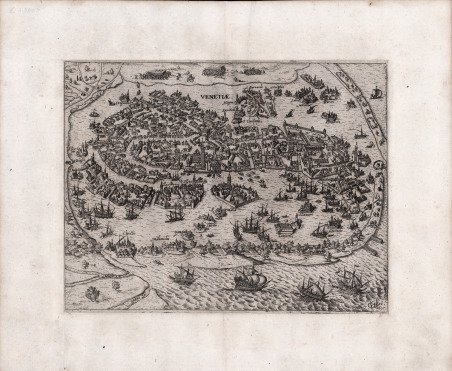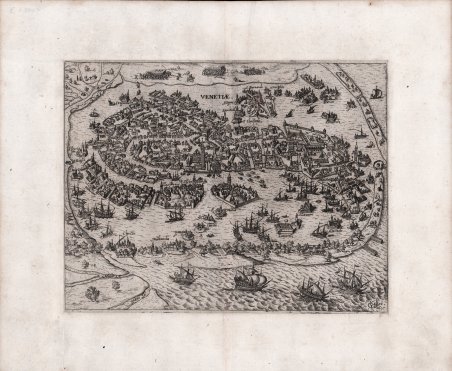LA GUERRA DELL'INTERDETTO Rara pianta prospettica della città incisa da Georg Keller nel 1607. ' La tavola è pubblicata nella Relationis Historicae Semestralis Continuatio… del 1607. L’opera, meglio conosciuta anche come “Messrelationen”, edita a Francoforte a partire dal 1591, veniva stampata in occasione delle fiere di primavera ed autunno, per fornire notizie sui principali avvenimenti internazionali il cui autore era Jacobus Francus, uno pseudonimo usato da diversi scrittori, inclusi Conrad Lautenbach e Conrad Memmius. “Georg Keller di Francoforte fu uno dei maggiori interpreti del cambiamento di gusto grafico della fine del ‘500, quando l’illustrazione eseguita su piastra di rame prese il sopravvento sulla silografia. Le sue numerose vedute di città risalgono senza eccezioni a modelli precedenti e spesso stranieri” (cfr. Cassini, Piante e vedute prospettiche di Venezia, 1970, p. 69). ' “La pianta della città con numerosi toponimi si rifà alle piante prospettiche della fine del XVI secolo riprendendo i motivi iconografici della pianta prospettica di F. Hogenberg. L’estensione nella raffigurazione della terraferma che comprende a sud la foce dell’Adige e del Po deriva dalla pianta di C. Stimmer. G. Keller (1568-1634) fu autore di numerose vedute di città incise a Berlino su lastre di rame” (cfr. Romanelli-Biadene, Venezia, Piante e Vedute, 1982 p. 37, n. 24). “Nella parte superiore è illustrato un trasferimento militare. Nella parte inferiore fa bella mostra una vistosa parata di navi” (cfr. Moretto, Venetia, Le immagini della Repubblica, 2001, p. 114, scheda 49). Come correttamente affermato da Moretto, rispetto alla tradizionale iconografia della città, la pianta presenta la raffigurazione di “elementi” militari. Come detto, la pianta è inserita nelle “Messerelationen”, ed è quindi una cosiddetta carta d’occasione, nata per descrivere un determinato avvenimento. In questo caso l’opera viene realizzata per documentare la cosiddetta guerra dell'interdetto (1606 – 21 aprile 1607). ' Fu una vertenza fra la Repubblica di Venezia e lo Stato Pontificio, scoppiata nel 1606 a causa dell'arresto a Venezia di due preti cattolici accusati di reati comuni e dell'adozione da parte della Serenissima di una serie di leggi volte al contenimento della proprietà ecclesiastica. Il pontefice Paolo V (1605 - 1621) minacciò di porre l'interdetto sulla città, ossia di colpirla con una sorta di scomunica collettiva che avrebbe posto Venezia al di fuori della Chiesa, impedendo ogni forma di amministrazione dei sacramenti: l'ultimatum papale fu respinto e il Papa mise in atto quanto aveva minacciato. Grazie alla mediazione della Francia, tuttavia, si giunse ad un compromesso: Venezia fu liberata dall'interdetto. Il foglio è pubblicato nella Relationis Historicae Semestralis Continuatio, Jacobi Franci Historische Beschreibung aller Denckwürdigen Geschichten, so sich hin und wider in Europa, Hoch- und Nider Teutschland, auch in Franckreich. L’opera, meglio conosciuta anche come “Messrelationen”, edita a Francoforte a partire dal 1591, veniva stampata in occasione delle fiere di primavera ed autunno, per fornire notizie sui principali avvenimenti internazionali. Le prime edizioni della raccolta erano firmate a nome di Jacobus Francus, che era lo pseudonimo usato da diversi scrittori, inclusi Conrad Lautenbach e Conrad Memmius. Una Messrelation era una pubblicazione stampata in occasione delle fiere del libro di Francoforte e Lipsia (le più grandi d'Europa all'epoca) che riportava notizie sulle novità politiche e militari dall'ultima fiera. Le Messrelationen sono viste come precursori dei moderni giornali, poiché furono i primi mezzi di informazione stampati ad essere pubblicati periodicamente. Lo studioso austriaco Michael von Aitzing (ca. 1530-1598) è comunemente considerato il loro inventore, avendo pubblicato per la prima volta una Relatio Historica (stampata a Colonia. THE WAR OF THE INTERDICT ' Rare perspective map of the city engraved by Georg Keller in 1607. The plate is published in the Relationis Historicae Semestralis Continuatio. of 1607. The work, also better known as "Messerelationen" published in Frankfurt beginning in 1598, was printed at spring and autumn fairs to provide news of major international events whose author was Jacobus Francus, a pseudonym used by several writers, including Conrad Lautenbach and Conrad Memmius. "Georg Keller of Frankfurt was one of the major interpreters of the change in graphic taste at the end of the 1500s, when illustration executed on copperplate took over from silography. His numerous views of cities go back without exception to earlier and often foreign models" (cf. Cassini, Piante e vedute prospettiche di Venezia, 1970, p. 69). ' "The plan of the city with numerous place names refers to the perspective plans of the end of the sixteenth century taking up the iconographic motifs of the perspective plan of F. Hogenberg. The extension in the depiction of the mainland, which includes the mouth of the Adige and the Po to the south, is derived from the plan of C. Stimmer. G. Keller (1568-1634) was the author of numerous views of cities engraved in Berlin on copper plates" (cf. Romanelli-Biadene, Venezia, Piante e Vedute, 1982 p. 37, n. 24). "In the upper part a military transfer is illustrated. In the lower part a showy parade of ships is on display" (cf. Moretto, Venetia, Le immagini della Repubblica, 2001, p. 114, plate 49). As correctly stated by Moretto, compared to the traditional iconography of the city, the map presents the representation of military "elements". As mentioned, the plan is included in the "Messerelationen", and is therefore a so-called "occasion" map, created to describe a specific event. In this case the work is made to document the so-called war of the interdict (1606 - April 21, 1607). It was a dispute between the Republic of Venice and the Papal State, which broke out in 1606 because of the arrest in Venice of two Catholic priests accused of common crimes and the adoption by the Serenissima of a series of laws aimed at the containment of ecclesiastical property. The pope Paul V (1605 - 1621) threatened to put an interdict on the city, that is to say to strike it with a sort of collective excommunication that would have placed Venice outside the Church, preventing any form of administration of the sacraments: the papal ultimatum was rejected and the Pope put into effect what he had threatened. Thanks to the mediation of France, however, a compromise was reached: Venice was freed from the interdict. The sheet is published in the Relationis Historicae Semestralis Continuatio, Jacobi Franci Historische Beschreibung aller Denckwürdigen Geschichten, so sich hin und wider in Europa, Hoch- und Nider Teutschland, auch in Franckreich. The work, also known as "Messerelationen", published in Frankfurt since 1598, was printed on the occasion of spring and autumn fairs, to provide news about major international events. Early editions of the collection were signed in the name of Jacobus Francus, which was the pseudonym used by several writers, including Conrad Lautenbach and Conrad Memmius. A Messrelation was a print published in the 16th to 18th century for the book fairs in Frankfurt and Leipzig (the largest in Europe at their time) which reported news about political and military news since the last fair. Messrelationen are seen as precursors to modern newspapers as they were the first printed news media to be published periodically. The Austrian scholar Michael von Aitzing (ca. 1530–1598) is commonly seen as their inventor, having published for the first time a Relatio Historica (printed in Cologne) at the autumn 1583 book fair in Frankfurt, in which he related the events in the Low Countries since February 1580. This was a huge success and from 1588 Aitzing published his "relations" twice a year, for the Easter book fair . Cfr.


Découvrez comment utiliser
Découvrez comment utiliser

